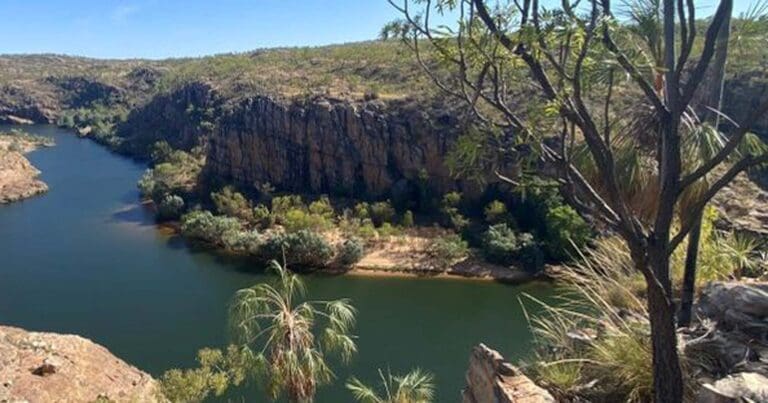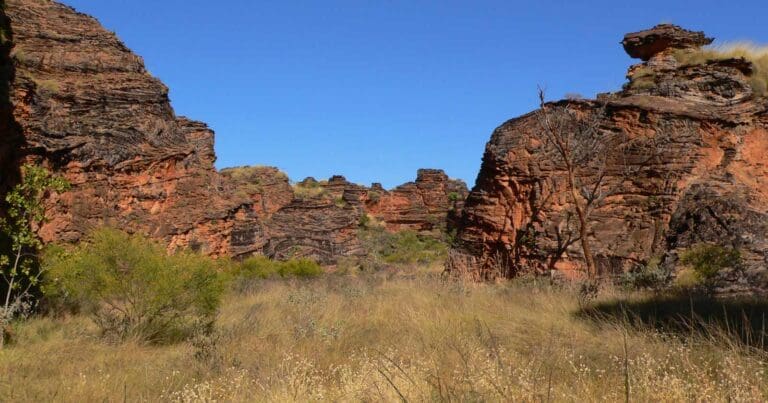Trail Fast Facts
Motor Car & Kurrundie Creek Walk is a 14km, grade 5 hike in Kakadu National Park, Northern Territory. This hike typically takes 1-2 days to complete.
Hike Overview
The Motor Car and Kurrundie Creek Walk is a challenging 14-kilometre out-and-back adventure for experienced hikers within Kakadu National Park, Northern Territory. Due to its length and remoteness, this hike is recommended for a full day or even an overnight stay. A camping permit is required for extended trips.
The initial section follows the marked track used for the Motor Car Falls walk, leading you to the picturesque falls themselves. After enjoying this natural wonder, the path continues along the older vehicle track until you reach Kurrundie Creek. From here, the track becomes unmarked as you follow the creek upstream to the awe-inspiring Kurrundie Falls. Keep an eye out for wildlife along the way – you might spot the majestic ngalmirlamirla (peregrine falcon) soaring from the cliffs or the watchful parrk (black wallaroo) amongst the rocky outcrops.
The return journey takes you downstream alongside Kurrundie Creek, where you'll encounter more waterfalls. However, be aware that this section leads to the South Alligator River, known saltwater crocodile habitat. Swimming here is strictly prohibited. Once you reach the creek junction, follow Motor Car Creek back to the old bridge and vehicle track, returning you to the starting point.
Given the remoteness of this area, it's crucial to be well-prepared. Carry a GPS or compass and a topographic map for navigation. A personal locator beacon is also recommended, and informing someone about your plans before setting off is essential. Remember, a park pass is required to enter Kakadu National Park. Consider purchasing yours online beforehand to save time upon arrival.
Nestled between the Marrawal Plateau and the South Alligator River lies Yurmikmik, a region named by the Jawoyn people. Hikers seeking to explore this area will find a network of trails particularly suited to the wet season. However, be cautious of sudden flash floods in the creeks during this time.
The walks offer a contrasting experience. As you traverse the paths, you'll transition from the cool embrace of monsoon forests and flowing creeks to the warmth of open woodlands. The vegetation also transforms, with towering trees in the valleys giving way to hardier, stunted plants on the rocky ridges and plateau.
All trails begin and end at the designated carpark. Shorter walks are clearly marked with either yellow-topped posts or orange arrows painted on rocks. If you choose a longer track, be aware that these are unmarked.
Camping: Permits are mandatory for camping in Yurmikmik. Camping is strictly prohibited near Motor Car Falls. To minimize environmental impact, bury toilet waste at least 15 centimetres deep and at least 100 metres from campsites and water sources. Wash well away from creeks and pools, and avoid using soap, shampoo, or detergent near water bodies as they can harm wildlife.
Important Safety Note: While Motor Car Creek is located upstream of known saltwater crocodile territory, these reptiles can still enter the area undetected during the wet season. Entering the water here is at your own risk. The South Alligator River, however, is confirmed saltwater crocodile habitat, and swimming there is strictly forbidden under any circumstances.
Image: ogwen, CC BY-SA 3.0, via Wikimedia Commons
Track Grade
Grade 5 (Difficult) - Walks for the Most Experienced: Grade 5 represents the most challenging walking tracks on the AWTGS. These are only recommended for very experienced and fit walkers with specialised skills, including navigation and emergency first aid. Tracks are likely to be very rough, very steep, and unmarked. Walks may be more than 20 kilometers. These challenging walks demand a high level of fitness and experience to navigate difficult terrain, significant elevation changes, and potentially unformed paths.
Tips
- Keep to marked tracks.
- Wear sturdy footwear.
- Carry and drink plenty of water.
- On longer walks, bring energy foods – fruit and nuts.
- Carry a First Aid Kit.
- Avoid walking in the heat of the day.
- Advise a responsible adult when you start and finish your walk.
Map and GPX file
Looks like I don’t have a GPX file for this trail yet. If you have one you’d be willing to share, please email it to me so we can help other hikers have a safer, easier time out there. I’ll double-check each file to make sure it aligns with official tracks and topo maps before adding it to this hike. Thanks so much for helping build an even better hiking resource.
Trailhead
Sorry, no records were found. Please adjust your search criteria and try again.
Sorry, unable to load the Maps API.
Getting there
Located within Kakadu National Park near Jabiru, the park's main entrance point, all the trails originate from a single carpark accessible via Gunlom Road. This eliminates the need to navigate between different trailheads, allowing you to focus on choosing the Yurmikmik adventure that best suits your interests and fitness level.
Photo gallery
If you’ve got some great shots from this hike, I’d love to see them! Please upload your .jpg files here to help inspire other hikers and show off the beauty of the trail.
A quick note: Uploading your photos doesn’t mean you lose ownership. You’ll be credited for any photos you share, and you can request to have them removed at any time.
About the region
Covering nearly 20,000 square kilometres, Kakadu National Park is a World Heritage listing renowned for both its cultural and natural values. See breathtaking horizons from the top of a Kakadu escarpment. Cruise on the stunning Yellow Water Billabong to spot crocodiles and wildlife in their natural habitat, including millions of migratory birds who in part call the park's wetlands home.
Not only is Kakadu spectacular, but you can feel yourself come alive among the lush rainforests, rocky gorges, serene swimming pools and the oldest Aboriginal rock art in the world. With more than 5,000 Aboriginal rock art sites in the park, the Bininj/Mungguy people have called Kakadu home for some 65,000 years. Here they'll teach you about their ancient culture and the regions' dramatic seasons.
Connect with the oldest living culture on earth. The rugged and remote beauty of Kakadu has stories to share that will take your breath away and touch your heart. In Australia's biggest national park you'll find ancient landscapes with thundering waterfalls, lush rainforests, wandering wetlands, exotic wildlife and ancient rock art.
Kakadu offers unrivalled walks to immerse you in nature, satisfy your appetite for adventure, or nurture your curiosity. Only three hours' drive from Darwin, Kakadu National Park has been waiting for you.
Suggest an edit
Spotted a change on this trail? Maybe there are new features, the route has shifted, or the trail is permanently closed. Whatever the update, I’d love your input. Your feedback helps fellow hikers stay informed and ensures that our trail info stays fresh and reliable.
Similar trails nearby
Looking for things to do in Kakadu National Park or nearby? Try these similar hikes or bushwalks.
Let someone know
Adventure with Confidence: Register Your Trip Plans
Before you hit the trail, take a moment to fill out our trip intentions form. It’s a simple way to share important details about your hike with family or friends. If things don’t go as planned and you’re not back on time, they can easily notify emergency services, helping to ensure a quick response and reducing worry. Enjoy your outdoor adventure knowing that you’ve taken a smart step for your safety.
Gear to consider
What you carry in your pack will depend on the weather, terrain, time of year, type of adventure, and personal preferences. Having trouble deciding what gear’s right for you? My free planning, food and packing checklists provide an introduction to things your could consider (as well as the Ten Essentials) on your day, overnight and multi-day adventures. Customise your kit according to your personal needs, always considering safety first.
Explore Safe
While planning your hike, it’s important to check official government sources for updated information, temporary closures and trail access requirements. Before hitting the trail, check local weather and bushfire advice for planned burns and bushfire warnings and let someone know before you go. Plan ahead and hike safely.
Weather
Acknowledgement of Country
Trail Hiking Australia acknowledges the Traditional Owners of the lands on which we hike and pay respects to their Elders, past and present, and we acknowledge the First Nations people of other communities who may be here today.






